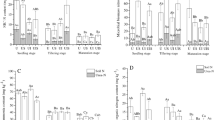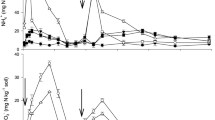Abstract
Improving nitrogen fertilizer use by plants and reducing N losses through applying the appropriate nitrogen (N) fertilizer rate with urease inhibitors (UIs) and nitrification inhibitors (NIs) may enhance crop production and the efficiency of N use. Sugarcane and unplanted plots were established in Central Thailand to investigate the effects of fertilizer application based on soil analysis and UIs, NIs and their combination (UINIs) on soil inorganic N, sugarcane productivity and N uptake. Both synthetic and natural inhibitors were investigated: UIs from N-(n-butyl) thiophosphoric triamide (NBPT) and garlic (Allium sativum L.) and NIs from dimethylpyrazole phosphate (DMPP), ground neem seed (Azadirachta indica A. Juss.) and praxelis (Praxelis clematidea (Griseb.) R.M. King & H. Rob). The results indicated the potential of applying UIs, NIs and UINIs along with N fertilizer to obtain a slower decrease in soil NH4+ and improve sugar products. The results indicated enhanced sugarcane growth and an apparent increase (up to 31%) in the cane and sugar yields in all the inhibitory treatments. Notably, despite the synthetic NIs and NIs from plants having similar effects on soil inorganic N, the natural NIs tended to enhance sugarcane yields and N uptake. These findings supported the application of UIs and NIs as a potential solution to reduce N fertilizer rates and N losses from soil, while increasing crop productivity. In addition, NIs from plants might be of interest for further investigation and for promotion to farmers.







Similar content being viewed by others
References
Arora, Kavita, and Alka Srivastava. 2013. Nitrogen losses due to nitrification: Plant based remedial prospects. International Journal of Bioassays 2: 984–991.
Bhanuvally, M., Y.M. Ramesha, and H. Yogeeshappa. 2017. Nutrient uptake and millable cane yield of sugarcane as influenced by application of slow releasing nitrogen fertilizers. International Journal of Current Microbiology and Applied Sciences 6: 855–862. https://doi.org/10.20546/ijcmas.2017.610.102.
Bremner, J.M. 1990. Problems in the use of urea as a nitrogen fertilizer. Soil Use and Management 6 (2): 70–71. https://doi.org/10.1111/j.1475-2743.1990.tb00804.x.
Bremner, J.M., A.M. Blackmer, and S.A. Waring. 1980. Formation of nitrous oxide and dinitrogen by chemical decomposition of hydroxylamine in soils. Soil Biology and Biochemistry 12 (3): 263–269. https://doi.org/10.1016/0038-0717(80)90072-3.
Bremner, John M. 1997. Sources of nitrous oxide in soils. Nutrient Cycling in Agroecosystems 49 (1): 7–16. https://doi.org/10.1023/A:1009798022569.
Byrne, Maria P., John T. Tobin, Patrick J. Forrestal, Martin Danaher, Chikere G. Nkwonta, Karl Richards, Enda Cummins, Sean A. Hogan, and Tom F. O’Callaghan. 2020. Urease and nitrification Inhibitors—as mitigation tools for greenhouse gas emissions in sustainable dairy systems: A review. Sustainability 12 (15): 1–35. https://doi.org/10.3390/su12156018.
Cambouris, Athyna N., Noura Ziadi, Isabelle Perron, Khaled D. Alotaibi, Mervin St, Nicolas Tremblay Luce, and X. Yang. 2016. Corn yield components response to nitrogen fertilizer as a function of soil texture. Canadian Journal of Soil Science 96 (4): 386–399. https://doi.org/10.1139/cjss-2015-0134.
Cameron, K.C., H.J. Di, and J.L. Moir. 2013. Nitrogen losses from the soil/plant system: A review. Annals of Applied Biology 162 (2): 145–173. https://doi.org/10.1111/aab.12014.
Chen, Deli, Helen C. Suter, Arshad Islam, and Robert Edis. 2010. Influence of nitrification inhibitors on nitrification and nitrous oxide (N2O) emission from a clay loam soil fertilized with urea. Soil Biology and Biochemistry 42 (4): 660–664. https://doi.org/10.1016/j.soilbio.2009.12.014.
Chen, Long-Fei., Zhi-Bin. He, Wen-Zhi. Zhao, Ji-Liang. Liu, Hai Zhou, Jing Li, Yang-Yang. Meng, and Li-Sha. Wang. 2020. Soil structure and nutrient supply drive changes in soil microbial communities during conversion of virgin desert soil to irrigated cropland. European Journal of Soil Science 71 (4): 768–781. https://doi.org/10.1111/ejss.12901.
Drury, C.F., X. Yang, W.D. Reynolds, W. Calder, T.O. Oloya, and A.L. Woodley. 2017. Combining urease and nitrification inhibitors with incorporation reduces ammonia and nitrous oxide emissions and increases corn yields. Journal of Environmental Quality 46 (5): 939–949. https://doi.org/10.2134/jeq2017.03.0106.
Fortes, Caio, Paulo César Ocheuze. Trivelin, André César. Vitti, Rafael Otto, Henrique Coutinho Junqueira. Franco, and Carlos Eduardo Faroni. 2013. Stalk and sucrose yield in response to nitrogen fertilization of sugarcane under reduced tillage. Pesquisa Agropecuária Brasileira 48 (1): 88–96. https://doi.org/10.1590/S0100-204X2013000100012.
Greenberg, A.E., L.S. Clesceri, and A.D. Eaton. 1992. Standard methods for the examination of water and wastewater. Washington DC: American Public Health Association.
Hirel, Bertrand, Thierry Tétu, Peter J. Lea, and Frédéric. Dubois. 2011. Improving nitrogen use efficiency in crops for sustainable agriculture. Sustainability 3 (9): 1452–1485. https://doi.org/10.3390/su3091452.
Hooper, A.B., T. Vannelli, D.J. Bergmann, and D.M. Arciero. 1997. Enzymology of the oxidation of ammonia to nitrite by bacteria. Antonie Van Leeuwenhoek 71 (1–2): 59–67. https://doi.org/10.1023/A:1000133919203.
Johnston, A.M., and T.W. Bruulsema. 2014. 4R nutrient stewardship for improved nutrient use efficiency. Procedia Engineering 83: 365–370. https://doi.org/10.1016/j.proeng.2014.09.029.
Kiran, Usha, and D.D. Patra. 2003. Medicinal and aromatic plant materials as nitrification inhibitors for augmenting yield and nitrogen uptake of Japanese mint (Mentha arvensis L. Var. piperascens). Bioresource Technology 86 (3): 267–276. https://doi.org/10.1016/S0960-8524(02)00143-8.
Kumar, M., N. Sikri, S. Chahal, J. Sharma, B. Sharma, P. Yadav, M. Bhardwaj, D. Vashishth, P. Kadyan, S.K. Kataria, and S. Dalal. 2021. Urease inhibitory kinetic studies of various extracts and pure compounds from cinnamomum genus. Molecules 26 (13): 1–10. https://doi.org/10.3390/molecules26133803.
Liu, S., J.J. Wang, Z. Tian, X. Wang, and S. Harrison. 2017. Ammonia and greenhouse gas emissions from a subtropical wheat field under different nitrogen fertilization strategies. Journal of Environmental Sciences 57: 196–210. https://doi.org/10.1016/j.jes.2017.02.014.
Mathialagan, Ranitha, Nurlidia Mansor, Beshr Al-Khateeb, Muhammad Helmi Mohamad, and Muhammad Rashid Shamsuddin. 2017. Evaluation of allicin as soil urease inhibitor. Procedia Engineering 184: 449–459. https://doi.org/10.1016/j.proeng.2017.04.116.
McCarty, G.W., and J.M. Bremner. 1989. Inhibition of nitrification in soil by heterocyclic nitrogen compounds. Biology and Fertility of Soils 8 (3): 204–211. https://doi.org/10.1007/BF00266480.
Nguyen, Cuong C., Thanh Q. C. Nguyen, Kenji Kanaori, Tran Duy Binh, Le. Van Vang, and Kaeko Kamei. 2021. Isolation and identification of antibacterial and antifungal compounds from Praxelis clematidea R. M. King & H. Robinson as an effective potential treatment against rice pathogens. Agronomy 11 (11): 2366–2376. https://doi.org/10.3390/agronomy11112366.
Norton, J., and Y. Ouyang. 2019. Controls and adaptive management of nitrification in agricultural soils. Frontiers in Microbiology 10: 1–18. https://doi.org/10.3389/fmicb.2019.01931.
Otaka, Junnosuke, Guntur Venkata Subbarao, Hiroshi Ono, and Tadashi Yoshihashi. 2021. Biological nitrification inhibition in maize—isolation and identification of hydrophobic inhibitors from root exudates. Biology and Fertility of Soils 58 (3): 251–264. https://doi.org/10.1007/s00374-021-01577-x.
Patra, D.D., M. Anwar, S. Chand, U. Kiran, D.K. Rajput, and S. Kumar. 2007. Nimin and Mentha spicata oil as nitrification inhibitors for optimum yield of Japanese mint. Communications in Soil Science and Plant Analysis 33 (3–4): 451–460. https://doi.org/10.1081/CSS-120002756.
Pawlick, Amy A., Claudia Wagner-Riddle, Gary W. Parkin, Aaron A. Berg, and Newton Lupwayi. 2019. Assessment of nitrification and urease inhibitors on nitrate leaching in corn (Zea mays L.). Canadian Journal of Soil Science 99 (1): 80–91. https://doi.org/10.1139/cjss-2018-0110.
Pengthamkeerati, P., and A. Modtad. 2016. Nitrification inhibitor, fertilizer rate, and temperature effects on nitrous oxide emission and nitrogen transformation in loamy sand soil. Communications in Soil Science and Plant Analysis 47: 1–8. https://doi.org/10.1080/00103624.2015.1122795.
Poffenbarger, Hanna, Mark S. Coyne, and Wilbur W. Frye. 2018. Nitrogen in soils/cycle. In Reference module in earth systems and environmental sciences, 1–13. Kentucky: Elsevier Publication.
Ruser, Reiner, and Rudolf Schulz. 2015. The effect of nitrification inhibitors on the nitrous oxide (N2O) release from agricultural soils-a review. Journal of Plant Nutrition Soil Science 178 (2): 171–188. https://doi.org/10.1002/jpln.201400251.
Rütting, T., H. Aronsson, and S. Delin. 2018. Efficient use of nitrogen in agriculture. Nutrient Cycling in Agroecosystems 110 (1): 1–5. https://doi.org/10.1007/s10705-017-9900-8.
Sadhukhan, Rahul, Hanuman Singh Jatav, Suman Sen, Laimayum Devarishi Sharma, Vishnu D. Rajput, Rojeet Thangjam, Anoop Kumar Devedee, Satish Kumar Singh, Andrey Gorovtsov, Sourav Choudhury, and Kiranmay Patra. 2022. Chapter 8–biological nitrification inhibition for sustainable crop production. In Plant perspectives to global climate changes, ed. T. Aftab and A. Roychoudhury, 135–150. Cambridge: Academic Press.
Salvagiotti, Fernando, Julio M. Castellarín, Daniel J. Miralles, and Hugo M. Pedrol. 2009. Sulfur fertilization improves nitrogen use efficiency in wheat by increasing nitrogen uptake. Field Crops Research 113 (2): 170–177. https://doi.org/10.1016/j.fcr.2009.05.003.
Signor, Diana, and Carlos Eduardo Cerri. 2013. Nitrous oxide emissions in agricultural soils: A review. Pesquisa Agropecuária Tropical 43: 322–338. https://doi.org/10.1590/S1983-40632013000300014.
Stein, L.Y., and D.J. Arp. 1998. Loss of ammonia monooxygenase activity in nitrosomonas europaea upon exposure to nitrite. Applied and Environmental Microbiology 64 (10): 4098–4102.
Subbarao, G.V., T. Ishikawa, O. Ito, K. Nakahara, H.Y. Wang, and W.L. Berry. 2006. A bioluminescence assay to detect nitrification inhibitors released from plant roots: A case study with Brachiaria humidicola. Plant and Soil 288 (1–2): 101–112. https://doi.org/10.1007/s11104-006-9094-3.
Subbarao, G.V., K. Nakahara, T. Ishikawa, H. Ono, M. Yoshida, T. Yoshihashi, Y. Zhu, H.A.K.M. Zakir, S.P. Deshpande, C.T. Hash, and K.L. Sahrawat. 2013. Biological nitrification inhibition (BNI) activity in sorghum and its characterization. Plant and Soil 366 (1–2): 243–259.
Subbarao, G.V., K.L. Sahrawat, K. Nakahara, T. Ishikawa, M. Kishii, I.M. Rao, C.T. Hash, T.S. George, P. Srinivasa Rao, P. Nardi, D. Bonnett, W. Berry, K. Suenaga, and J.C. Lata. 2012. Chapter six–Biological nitrification inhibition—a novel strategy to regulate nitrification in agricultural systems. In Advances in agronomy, ed. D.L. Sparks, 249–302. Cambridge: Academic Press.
Subbarao, G.V., T. Yoshihashi, M. Worthington, K. Nakahara, Y. Ando, K.L. Sahrawat, I.M. Rao, J.C. Lata, M. Kishii, and H.J. Braun. 2015. Suppression of soil nitrification by plants. Plant Science 233: 155–164. https://doi.org/10.1016/j.plantsci.2015.01.012.
Sun, Jianbo, Wenbin Li, Chunqiang Li, Wenjun Chang, Shiqing Zhang, Yanbo Zeng, Changying Zeng, and Ming Peng. 2020. Effect of different rates of nitrogen fertilization on crop yield, soil properties and leaf physiological attributes in banana under subtropical regions of China. Frontiers in Plant Science 11: 1–11. https://doi.org/10.3389/fpls.2020.613760.
Suter, H.C., H. Sultana, R. Davies, C. Walker, and D. Chen. 2016. Influence of enhanced efficiency fertilisation techniques on nitrous oxide emissions and productivity response from urea in a temperate Australian ryegrass pasture. Soil Research 54 (5): 523–532.
Thepphakhun, Tamonwan, and Suphannika Intanon. 2020. Total phenolics, flavonoids, antioxidant activity, and allelopathic potential of praxelis. Journal of Current Science and Technology 10: 59–65.
Upadhyay, R.K., D.D. Patra, and S.K. Tewari. 2011. Natural nitrification inhibitors for higher nitrogen use efficiency, crop yield, and for curtailing global warming. Journal of Tropical Agriculture 49: 19–24.
Wang, J., S. Hussain, X. Sun, P. Zhang, T. Javed, E.S. Dessoky, X. Ren, and X. Chen. 2022. Effects of nitrogen application rate under straw incorporation on photosynthesis, productivity and nitrogen use efficiency in winter wheat. Frontier in Plant Science 13: 1–13. https://doi.org/10.3389/fpls.2022.862088.
Yang, Jian Ni, Xiu Qiao Zhou, Xu Hua Nong, Jian Cao, Yang Hui, Mian Wen, and Wen Hao Chen. 2020. Phytochemical investigation of the flowers of Praxelis clematidea (Griseb.) R.M. King & H Rob. Natural Product Research 35: 3504–3508. https://doi.org/10.1080/14786419.2019.1709189.
Zhao, Hui, Xuyong Li, and Yan Jiang. 2019. Response of nitrogen losses to excessive nitrogen fertilizer application in intensive greenhouse vegetable production. Sustainability 11 (6): 1513–1527. https://doi.org/10.3390/su11061513.
Acknowledgements
The Thailand Research Fund provided financial support from the Royal Golden Jubilee Ph.D. program [Grant No. PHD/0154/2559] to Miss Phatchariya Welutung and Assoc. Prof. Dr. Patthra Pengthamkeerati. We are grateful for research area support from the Lop Buri Research Station, Faculty of Agriculture, Kasetsart University, Lop Buri province, Thailand. Lastly, we thank Assoc. Prof. Dr. Srunya Vajrodaya, Kasetsart University for technical help.
Author information
Authors and Affiliations
Corresponding author
Ethics declarations
Conflict of interest
The authors declare that we have no conflict of interest. The authors declare that they have no known competing financial interests or personal relationships that could have appeared to influence the work reported in this paper.
Additional information
Publisher's Note
Springer Nature remains neutral with regard to jurisdictional claims in published maps and institutional affiliations.
Rights and permissions
Springer Nature or its licensor (e.g. a society or other partner) holds exclusive rights to this article under a publishing agreement with the author(s) or other rightsholder(s); author self-archiving of the accepted manuscript version of this article is solely governed by the terms of such publishing agreement and applicable law.
About this article
Cite this article
Welutung, P., Pengthamkeerati, P., Tawornpruek, S. et al. Fertilizer Rate and Urease and Nitrification Inhibitors Effects on Soil Inorganic Nitrogen and Sugarcane Yields in Central Thailand. Sugar Tech 25, 1070–1081 (2023). https://doi.org/10.1007/s12355-023-01282-z
Received:
Accepted:
Published:
Issue Date:
DOI: https://doi.org/10.1007/s12355-023-01282-z




